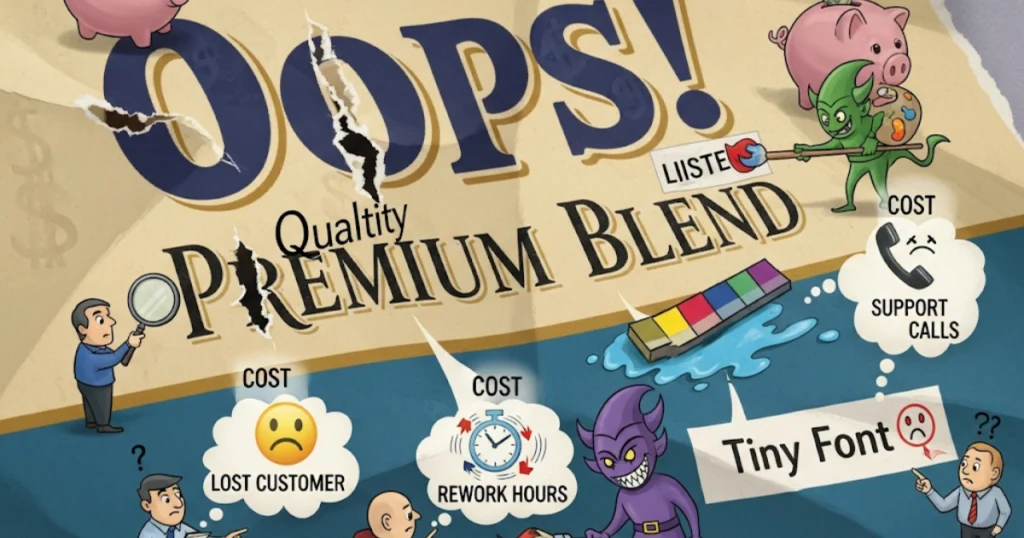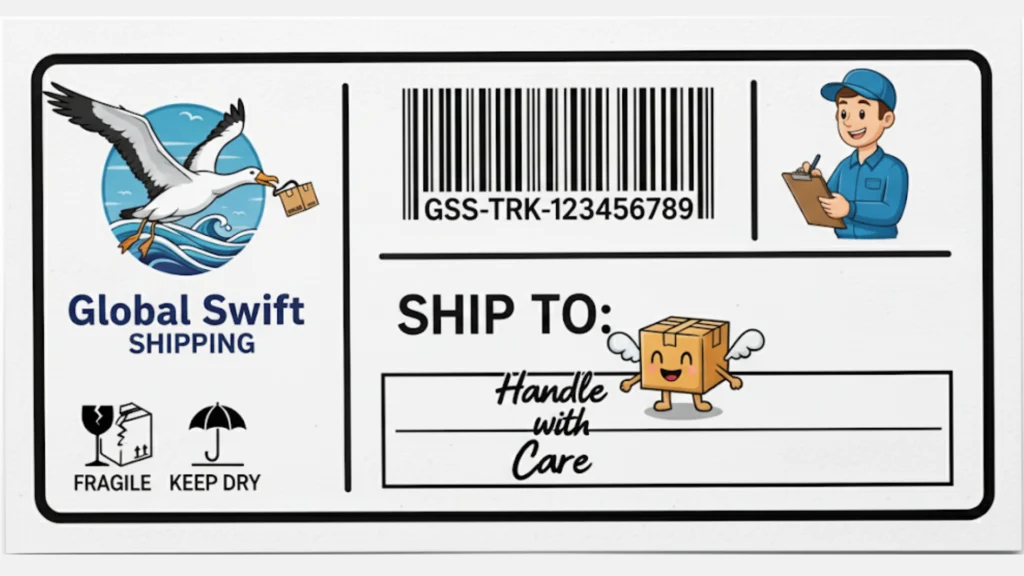Picture this: You've just landed your first big order, you're doing a victory dance around your home office, and then reality hits - how do you actually label this thing for shipping? If you're staring at your product like it's speaking ancient Greek, you're not alone. Product labelling for shipping can feel overwhelming for new sellers, but it doesn't have to be rocket science.
Think of product labels as your package's passport; they need the right information to travel safely from point A to point B. Get it wrong, and your carefully crafted product might end up on an unplanned vacation to the wrong state. Let's break down everything you need to know about creating foolproof shipping labels that even your sleep-deprived, coffee-fueled entrepreneur brain can handle.
Why Proper Product Labelling Matters More Than You Think
We've all heard horror stories about packages ending up in the wrong city, state, or even country because of labelling errors. While these mix-ups might seem funny from the outside, they're a nightmare scenario for any business owner. Properly labelling a package prevents these costly mistakes and saves your reputation (and sanity).
Here's what happens when you nail your labelling process:
- Faster delivery times
- Fewer lost packages
- Reduced customer service headaches
- Professional brand image
The Essential Elements Every Product Label Must Have

Missing even one crucial element in your product label can turn your perfectly packed product into a logistics nightmare. Let's break down what every professional shipping label absolutely must include.
Sender Information: Your Business Card on Every Package
Your sender information is like your business's calling card. Include your complete business name, full address (including suite numbers if applicable), and phone number. Skip the cute nicknames here - "Sarah's Super Stuff" might work for Instagram, but shipping carriers prefer professional, complete business names.
Pro tip: If you're shipping from home, consider using a PO Box or business address service. It looks more professional and protects your privacy.
Recipient Details: Getting It Right the First Time
This is where attention to detail becomes your superpower. One wrong digit in a zip code, and your package might tour the country like it's on a sightseeing trip. Double-check the recipient's name spelling, complete address, and zip code.
If you're selling to businesses, include the company name AND the person's name. "John Smith, ABC Company" ensures your package reaches the right hands, not the general mail room, where packages go to disappear.
Package Contents and Weight Information
Here's where many new sellers stumble. The product information requirement isn't just bureaucratic red tape; it's essential for carrier handling and customs (for international shipments).
Include:
- Brief, accurate description of contents
- Total package weight
- Quantity of items
- Value of contents (especially important for insurance claims)
Instead of writing "stuff" or "merchandise," be specific: "2x Cotton T-shirts, Size Medium." Carriers and customs officials appreciate clarity, and it protects you if something goes wrong.
Smart Packaging Choices That Save Money
Cost efficiency within labelling starts with smart packaging decisions. A slightly smaller box can bump you down to a lower shipping tier, potentially saving $3-5 per package. When you're shipping hundreds of items monthly, that adds up faster than your morning coffee habit.
Consider these money-saving strategies:
- Use poly mailers for non-fragile items (lighter = cheaper shipping)
- Invest in a digital scale to avoid dimensional weight surprises
- Pre-print address labels in bulk to reduce per-unit costs
- Choose packaging that fits standard carrier size categories
Barcode and Tracking Integration
Modern shipping labels aren't complete without scannable barcodes. These little zebra stripes are your package's GPS system, allowing you and your customers to track shipments in real-time. Most shipping platforms automatically generate these but always verify that they're clear and properly positioned.
Position barcodes on flat surfaces, away from edges and seams. A crumpled or partially obscured barcode is like giving directions with half the street signs missing, technically possible but unnecessarily frustrating.
The Complete Labelling Process for Shipping Success
Step 1: Information Gathering and Verification
Before you touch a single label, gather all necessary information. Create a simple checklist:
- Verified shipping address
- Correct package weight and dimensions
- Accurate contents description
- Appropriate shipping service selected
- Insurance and signature requirements confirmed
This labelling process for shipping might seem tedious initially, but it becomes second nature after a few dozen packages. Think of it as your pre-flight checklist, however boring it’s essential.
Step 2: Label Creation and Placement
Use professional shipping software or your carrier's online platform to generate labels. These systems automatically format information correctly and include necessary barcodes and routing information.
Placement matters: Position labels on the largest flat surface, parallel to the longest edge. Avoid placing labels over seams, tape, or corners where they might peel or become unreadable.
Step 3: Quality Control and Documentation
Before sealing that package, do a final visual check. Is everything spelled correctly? Are all barcodes clear? Is the label securely attached? Keep copies of all shipping labels and tracking numbers for your records.
International Shipping: Extra Requirements You Can't Ignore
If you're shipping internationally (and why wouldn't you want global domination?), additional documentation is required. Customs forms, harmonized tariff codes, and country-specific restrictions become part of your labelling reality.
Research destination country requirements thoroughly. Some countries prohibit certain materials or require specific declarations. The extra effort pays off when your international packages arrive without delays or additional fees.
Common Labelling Mistakes That Cost You Money

Even experienced sellers make labelling errors that result in delayed deliveries, frustrated customers, and unexpected fees. Learning to avoid these common pitfalls can save you both money and reputation damage while keeping your customers happy.
The "Good Enough" Trap
Using handwritten labels might work for birthday cards to grandma, but professional shipping demands a professional presentation. Illegible handwriting causes delays, returns, and frustrated customers. Invest in a basic label printer; your future self will thank you.
Ignoring Package Dimensions
Many new sellers focus solely on weight while ignoring dimensions. Shipping carriers use dimensional weight pricing for larger packages, meaning a lightweight but bulky package might cost more to ship than expected. Measure twice, ship once.
Inadequate Package Protection
Your beautiful labels won't help if they're illegible due to weather damage. Use clear packing tape over labels or invest in waterproof labels for added protection. A $0.10 piece of extra tape is cheaper than reshipping a lost package.
Building a Sustainable Labelling System
As your business grows, your labelling process needs to scale with you. What works for 10 orders weekly might crumble under 100 orders daily. Plan for growth by:
- Establishing standardized procedures
- Investing in quality equipment early
- Training team members thoroughly
- Regularly reviewing and optimizing processes
Your Path to Shipping Label Success

Mastering product labelling for shipping isn't just about following a routine. It's about creating systems that support your business growth while keeping customers happy. Remember, professional labelling reflects your brand's commitment to quality and customer service. When customers receive perfectly labeled packages that arrive on time and in perfect condition, you're building trust that translates into repeat business and positive reviews.
At Shopinbos, we specialize in helping new eCommerce entrepreneurs navigate the complex world of fulfilment with beginner-friendly solutions. From choosing the right labelling systems to optimizing your entire shipping workflow, we've got the experience and expertise to help you succeed. Visit Shopinbos.com today and let us simplify your shipping solutions so you can focus on what you do best - growing your business.
FAQs About Product Labelling for Shipping
Do I need a commercial address for shipping labels?
No, you can use a residential address but consider a business address or PO Box for a more professional appearance and privacy protection.
What happens if I make a mistake on a shipping label?
Most carriers allow label corrections within a specific timeframe. Contact your carrier immediately to void the incorrect label and create a new one. Some charges may apply.
Can I reuse shipping boxes with old labels still attached?
Always remove or completely cover old labels and barcodes. Multiple labels confuse sorting systems and can cause delivery delays or misdirection.
How do I handle oversized or oddly shaped packages?
Use the largest flat surface available for labelling and contact your carrier for specific guidelines. Some items may require special handling or additional labelling requirements.

